The Laws of Motion (planetary orbits)
Whilst CalQlata has adopted 'U' to symbolise energy, with due respect to Henri Poincaré we have adopted his symbol 'E' for this page

The four principle agents for the theories of planetary motion were Copernicus, Kepler, Galileo and Newton. Between them, they defined the behaviour of orbiting satellites, moons and planets that remain valid 400 years later.
A calculator is now available for Isaac Newton's laws of motion
Nicolaus Copernicus (1473 to 1543)
Copernicus stated that; contrary to religious doctrine, the sun does not orbit the earth, but all the planets in the solar system orbit the sun. He was so concerned for his safety⁽¹⁾ regarding this claim, however, that he arranged for the publication of his findings to be deferred until after his death (1543).
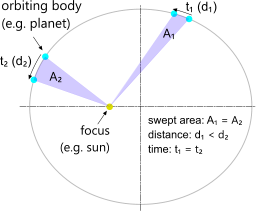
Fig 2. Principal Theory of Motion
Johannes Kepler (1571 to 1630)
Kepler used Tycho Brahe's (1546 to 1601) observational data to show that the planets not only orbited the sun, just as Copernicus had previously claimed, but that their orbital paths were ellipses. Kepler also stated that the time taken to traverse between any two points (see Fig 2) on this elliptical curve is proportional to the swept area:
i.e; t₁/A₁ = t₂/A₂
Whilst he did not provide a mathematical proof for his swept area theory, it was later confirmed by Isaac Newton (below).
Galilei Galileo (1564 to 1642)
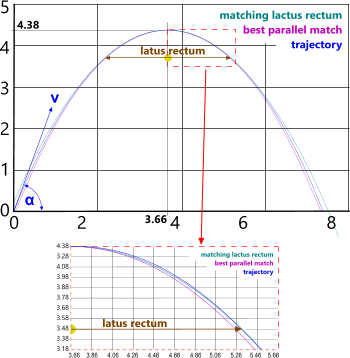
Fig 3. Falling Body = Parabolic Curve
Galileo is best known for his physical evidence of celestial bodies (moons) orbiting other planets, revealed in his book; Dialogue Concerning the Two Chief World Systems (frequently referred to as the 'Dialogue'), therein declaring Copernicus correct and finally quashing over a thousand years of religious dogma that stated all celestial bodies orbit the earth. In return for his findings, he was put under permanent house arrest, but only after being threatened with death if he didn't recant this claim⁽¹⁾.
However, it was during his confinement that Galileo completed his most important work, his laws of motion, one of which states that a body fired from the surface of the earth would follow a parabolic curve back to its surface.
This claim may be demonstrated by comparing the results from 'best-match' examples of Galileo's parabolic equations with a trajectory calculation⁽²⁾ (Fig 3), where:
v = initial velocity
A = initial horizontal velocity {i.e.; A=v.Cos(α)}
B = offset horizontal distance from t=0
C = initial vertical velocity {i.e.; C=v.Sin(α)}
D = offset vertical distance from t=0
x(t) = A.t + B
y(t) = C.t + D - ½.g.t²
If B and D are zero {i.e. v occurs at t=0}:
x(t) = v.Cos(α).t
y(t) = v.Sin(α).t - ½.g.t²
Whilst the parabolic path is not strictly correct, it is stunningly close as can be seen in the example shown in Fig 3 where two alternative parabolic curves, one of which passes through the same latus rectum and the other being the best parallel match, are superimposed on the path followed by the projectile
Isaac Newton (1642 to 1727)
Along with [his explanation for] gravity, Newton used [his creation of] calculus⁽³⁾ to mathematically prove the theories previously generated by Copernicus, Kepler and Galileo. In 1687 he published his results under the heading Philosophiæ Naturalis Principia Mathematica (first of three issues), probably the most important scientific work ever produced.
In his Principia, Newton discusses the alternative curves that describe the elliptical paths followed by an orbiting body. However, the parabolic and hyperbolic curves can only be responsible for paths followed by a body (e.g. comet) travelling towards a force centre from well outside its influence, sufficiently close to fall under its influence, pass around the force centre and then travel back out of its influence (see Elliptical Curves). A complete orbit (i.e. that of a planet or moon or a returning comet {e.g. Halley's}) must be an ellipse.

Fig 4. Gravitational Constant
As a result of this work, Newton defined the fundamental relationship (G) between attracting bodies (Fig 4) in which the gravitational force (F) is directly proportional to the inverse of the square of the distance (R) between the attracting bodies (see The Inverse Square Law below).
Whilst a value for 'G' was never established by Newton, despite it being of special importance to his theories, it has been estimated many times since the publication of the Principia, varying between 6.67E-11 and 6.76E-11 N.m²/kg² (see Gravitational Constant below)
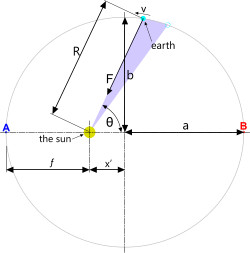
Fig 5. Earth's Orbital Path
The minimum and maximum distances between the earth and sun (Fig 5: @ A & B respectively) are assumed to be as defined in the EarthSky fact sheet⁽⁴⁾. Therefore, using Newton's theories and value of 6.671282E-11N.m²/kg² for 'G', the principal properties of the earth's orbit are as follows:
a = 1.495945981E+11m (R + R)/2)
b = 1.495737135E+11 {√[a².(1-e²)]}
e = 0.01670914665 {a.e² + R.e + R - a = 0}
p = 1.495528319E+11m {a.(1-e²)}
ƒ = 1.47095E+11m {a.(1-e)}
x' = 2.499598078E+09m {a-ƒ}
F = 3.658178805E+22N to 3.421649078E+22
v = 30286.008788376m/s to 29290.53557m/s
R = 1.47095E+11m to 1.520941962E+11m⁽⁵⁾
Newton's creation of Calculus allowed him to generate formulas for non-linear versions of Galileo's relationships for distance (s), time (t), velocity (v) and acceleration (a) (see Calqlata's velocity and acceleration calculator) as follows:
s = ut + ½at²
δs/δt = v = u + at
δ²s/δt² = δv/δt = a
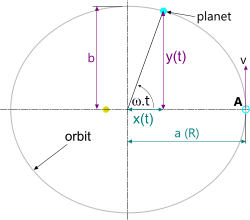
Fig 6. Proof of an Elliptical Orbit
Proof (elliptical orbits)
By applying calculus, Newton was able to generate the non-linear formulas necessary to complete his theories concerning the elliptical (conic) path of orbiting bodies, which was proven as follows:
Assume an ellipse and the planet is passing the x-axis @ 'A' (y=0) (Fig 6)
x component = R {a}
y component = v/ω {b}
x(t) = R.Sin(ω.t)
y(t) = (v/ω).Cos(ω.t)
From: Sin²(ω.t) + Cos²(ω.t) = 1
y(t)² / (v/ω)² = 1 - Sin²(ω.t)
Sin²(ω.t) = 1 – y(t)² / (v/ω)²
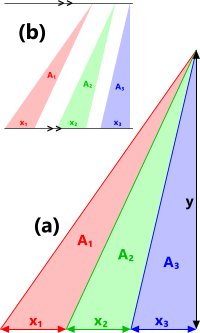
Fig 7. Euclidean Geometry
x(t)² / R² = Sin²(ω.t) = 1 – y(t)² / (v/ω)²
x(t)² / R² = 1 – y(t)² / (v/ω)²
x(t)² / R² + y(t)² / (v/ω)² = 1 (an ellipse!)
Equal Area (Euclidean Geometry)
Whilst Kepler had already predicted the equal-swept-area-with equal-orbital-time theory, it had still not been mathematically proven by the time Newton was writing his Principia. Newton did this by using Euclidian geometry.
The areas of each triangle in Fig 7; A₁, A₂ & A₃ are all equal if the base widths; x₁, x₂ & x₃ are equal, which can be proven as follows:
Let y=6 and x₁, x₂ & x₃ all equal 3
(a)
The area of a triangle: A = x.y/2
A₁ = 6 x 3 ÷ 2 = 9
A₂ = 6 x (3+3) ÷ 2 - A₁ = 9
A₃ = 6 x (3+3+3) ÷ 2 - A₁ - A₂ = 9
Therefore, all the areas are equal (i.e. 9)
The same applies to triangles with equal bases between parallel lines (b)
Proof (conservation of energy & equal time-swept area) {© 05/03/16}
Newton's proposition diagram for his proof of Kepler's 'equal-areas-equal-time' theory is shown in Fig 8, where the following instructions describe its construction (CalQlata's words):
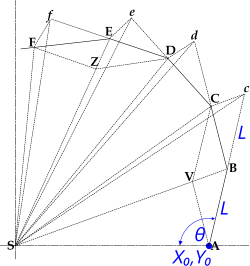
Fig 8. Newton's Proof
1) Divide time [of orbit] into equal parts [represented by equal swept areas {triangles}]
2) Assume the line A-B describes the linear path of the body if unconstrained by gravitational attraction
3) The same body would then continue to B-c
4) Assume that the body is attracted by a central-force (S) and diverted from its right line (B-c) in a direction parallel to V-B as far a C
5) Continue to generate similar triangles (S-A-B) following the points D, E, F, etc.
Note: The dimensions L, θ, X₀ & Y₀ in Fig 8 were not part of Newton's original drawing. They have been added by CalQlata in order to assist with the correlation between Figs 8, 9 & 10
Newton was therefore stating that all swept areas (triangles SAB, SBC, SCD, SDE, SEF, etc.) must be equal.
The difficulty in generating the above diagram is knowing how far along the line C-c that C occurs in order to ensure that each subsequent area remains equal.
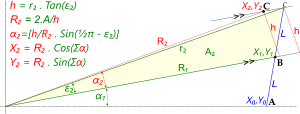
Fig 9. Unknown Variables
This can be achieved using the process described in Fig 9, where all the blue variables are entered (X₀, Y₀, L, θ {Fig 8}), all the green variables (X₁, Y₁, R₁, r₂, A₂, ε₂, X₀, α₁) can be easily calculated using the blue variables and the red variables (h, R₂, α₂, X₂, Y₂) may be determined using the formulas provided.
Newton claimed that if you reduce length L 'in infinitum' and join up the dots (X,Y co-ordinates) you produce a curved line thereby demonstrating that a centripetal force is continually acting on the body in the direction of the force centre and the triangular areas will always be proportional to the time passed by the body traversing each triangle; QED
This argument is less easily seen from his words and his fairly simple diagram (Fig 8) than if you actually complete his diagram and repeat it for ever smaller values of L
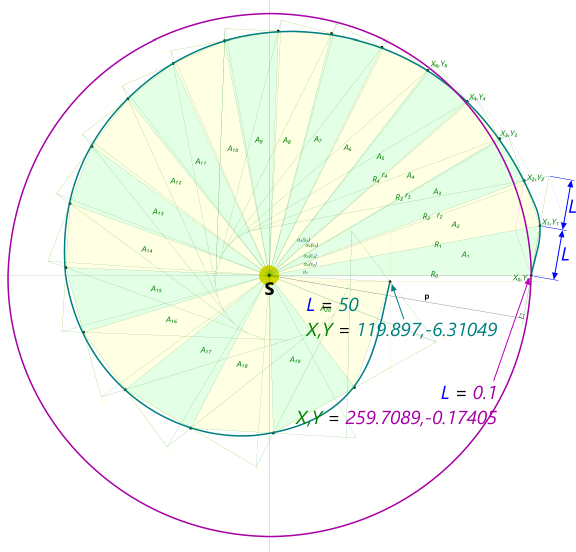
Calculations and associated plots were carried out by CalQlata using the following input data:
X₀,Y₀ = 260,0
L = 50
θ = 100°
As can be seen in Fig 10, the diagram does indeed produce a curve, exactly as Newton claimed
... and following this through a sequence of diminishing values for L from 50 to 0.1, the following X,(Y) co-ordinates are achieved immediately prior to reaching 360°:
| L | X | (Y) |
|---|---|---|
| 50 | 119.8970215 | (-6.310487628) |
| 25 | 179.800507 | (-11.66860541) |
| 10 | 229.5181732 | (-9.486414926) |
| 1 | 257.0676077 | (-0.349331185) |
| 0.1 | 259.7089445 | (-0.174048539) |
Note: the 'Y' co-ordinate is in parenthesis because it is simply a resultant. The trend is demonstrated by the 'X' co-ordinate.
... from which it isn't difficult to anticipate where X (& Y) will end up if L is diminished in infinitum [i.e.: X(,Y) = 260(,0)], making the final shape a circle and thereby proving that:
a) the path of the body is continuous (conservation of energy and angular momentum)
b) the orbital time passed by the body is proportional to the swept area (triangle)
c) his calculus can be used to determine the properties of the path {'in infinitum'}
This result does not mean that the orbital path is circular, simply that it is continuous.
The orbital path is calculated using the procedure provided in Elliptical Orbit above.
Corollary 1
Newton's first Corollary (to the above proof) states that the velocity of the body (v), represented by L, at positions A, B, C, D, E, F, etc. (Fig 8) is inversely proportional to the perpendicular distance of its tangent from the force centre (Fig 10; p)
Newton also stated that; v multiplied by p is a constant, i.e. his constant of motion (h), which is the angular momentum without the mass component.
Using the above 'in infinitum' argument it can be seen in the following table where these calculations have been carried out for successively reduced values of L between the start and end of the orbit (h₀ @ 0°, h < 360°), 'h' does indeed become a constant:
| L | h₀ | h |
|---|---|---|
| 50 | 2201.214 | 7485.049 |
| 25 | 580.0837 | 1196.551 |
| 10 | 95.12179 | 123.8112 |
| 1 | 0.963516 | 0.992077 |
| 0.1 | 0.0970 | 0.0974 |
Newton's constant of motion 'h' is not to be confused with the perpendicular distance 'h' shown in Fig 9; they are neither the same nor in any way connected.
See Constant of Motion below
Centripetal Force
Centrifugal acceleration (according to Christiaan Huygens {1629 to 1695}): α = R.ω²
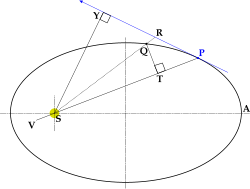
Fig 11. Newton's Diagram for Proposition VI
where ω = 2.π/t
a = √[(R.ω²)² + (R.α)²]
with constant angular momentum; α = 0
a = R.ω²
a = R.(2.π/t)²
Centrifugal force:
F = m.a
F = m.R.(2.π/t)² = 4.π².m (R/t²)
Through his inverse rules, Newton shows that the centripetal force (F) between the orbiting body and the force-centre (Fig 11);
F = SP² . QT² / QR
PR = vᴾ . δt
where; vᴾ is the velocity of the body at P and δt is the time taken for the body to travel from P to Q
QR = (Fᴾ / 2m).δt²
where; Fᴾ is the centripetal force on the body at P
F = QR . (2m / δt²)
where; Fᴾ is the centripetal force on the body at P
δt = PR/vᴾ = PR / (h/SY) = PR . SY / h
where h is Newton's constant of motion (see Corollary 1 above)
Therefore, the centripetal force (F) can be calculated as follows:
F = QR . (2.m / (PR . SY / h)²)
= QR . (2.m / (PR² . SY² / h²))
= QR . (2.m.h² / (PR² . SY²))
= QR.2.m.h² / PR².SY²
Newton preferred the calculation in geometric form by setting 2.m.h² as a constant (k):
F = k.QR / (PR.SY)²
See Elliptical Curves for a simple method to determine the angle of a tangent (PY).
Distance Between Bodies (R)
The separation (distance) between an orbiting body and its force centre, can be found by using general elliptical equation: R = a.(1-e²) / (1-e.Cos(θ))
where 'R' & 'θ' are as shown in (Fig 5) and 'e' is eccentricity
The force centre is not at the centre of an ellipse but at its focus (Fig 11; S)
The Inverse Square Law
Proposition XI: “If a body revolves in an ellipse; it is required to find the law of the centripetal force tending to the focus of the ellipse”
Using similar geometric arguments as above (Figs 7 to 11) Newton worked out that the force between an orbiting body and its force centre is proportional to the inverse of their separation (the distance between them): F ∝ 1/R²
i.e. F = K / R²
where:
the constant of proportionality: K = G.m₁.m₂
i.e. F = G.m₁.m₂ / R²
where G is a constant and m₁ and m₂ are the masses of the force centre and the orbiting body
This same relationship (F ∝ 1/R²) also applies to parabolas and hyperbolas as well as the ellipse
The above constant of proportionality (K) can also been written as; K = m.h²/p
Where 'h' and 'p' are defined in Corollary 1 above and m is the mass of the orbiting body
i.e. F = (m.h²/p).(1/R²)
In the first formula, you can resolve the problem knowing the mass of the bodies
In the second formula, you can resolve it knowing the velocity and mass of the orbiting body and the parameter of its curve (p)
Both of the above F calculations produce the same result;
e.g. the following centripetal force occurs in the earth's orbit, 0.000175° from the major semi-axis:
G = 6.67359232004332E-11 (gravitational constant)
m₁ = 1.9885E+30 (sun mass)
m₂ = 5.964519768E+24 (earth mass)
R = 1.5209420E+11 (distance between mass centres)
F = G.m₁.m₂ / R² = 3.421649078E+22 (centripetal)
h = 4.454920463E+15 (constant of motion - see Corollary 1 above)
m = 5.964519768E+24 (earth mass)
p = 1.495528319E+11 (ellipse parameter)
R = 1.5209420E+11 (distance between mass centres)
F = m.h² / p.R² = 3.421649078E+22 (centripetal)
Orbital Period
Proposition XV: “The same things being supposed, I say, that the periodic times in ellipses are as the 3/2th power of their greater axes”
This means that if the major semi-axis of an ellipse is 'a' (Fig 6) and the time taken for a body to orbit the elliptical path is 't' then the relationship between the two is:
t ∝ (2.a)¹˙⁵ or t² ∝ (2.a)³
Therefore; t = K . a¹˙⁵
Where K is the constant of proportionality, which is dependent on the properties of the force-centre.
This is actually Kepler's third law
Magnificent Principia
Some of what has been generated above has been inferred from or based upon Colin Pask's "Magnificent Principia"⁽⁵³⁾, an invaluable book that we wholeheartedly recommend.
CalQlata's Contribution {© 05/03/16}
Everything under this heading down to the foot of this page is CalQlata's own contribution to Newton's magnificent work
Centrifugal Acceleration
Provided below are two alternative calculation methods for deriving the relationship between potential acceleration and orbital velocity in circular orbits.
The governing formulas can be found below in The Formulas:
Governing Formulas:
PE = -G.m₁.m₂/R
g = -G.m₁/R²
KE = ½.m₂.v²
v = 2πR/t
K = t²/R³ = (2π)² / G.m₁
a = ³√[ t²/K ]
b = √[a².(1-e²)]
In circular orbits; a = b = R
Method 1):
t².G.m₁/R³ = (2π)²
t².(-G.m₁/R²)/R = (2π)²
t².-g/R = (2π)²
-g = R.(2π)²/t²
-g.R = R².(2π)²/t²
-g.R = (2πR/t)² = v²
g = -v²/R
Method 2):
R = ³√[ t²/K ] = √[a².(1-e²)]
R = ³√[ t²/K ] = √[R².(1-0²)] {eccentricity of a circle is zero}
R = ³√[ t²/K ] = R
t²/R³ = (2π)² / G.m₁
1/R = (2πR/t)² / G.m₁
1/R = v² / G.m₁
-G.m₁/R = v²
-G.m₁/R² = v²/R
g = -v²/R
Circular Orbits
Provided below is the proof of the relationship PE = 2.KE in circular orbits.
The governing formulas can be found below in The Formulas:
K = t²/R³ = (2π)² / G.m₁
-G.m₁/R = R².(2π)² / t²
-G.m₁.m₂/R = (2πR/t)².m₂
-G.m₁.m₂/R = v².m₂
PE = -2.KE
Note: PE = -G.m₁.m₂/R & KE = ½.m₂.v² which is the final proof of Henri Poincare's formula E=mc²
Constant of Proportionality
To determine 'K' (the constant of proportionality for t = K . a¹˙⁵ {Orbital Period above}) ...
K = t² / a³ {s²/m³}
now we know ...
... that the earth travels around the sun in 31558149s
... the earth's semi-major orbital x-axis is 1.495945981E+11m
therefore t² / a³ = 2.974914364E-19 {s²/m³}
G = 6.67359232E-11 {N.m²/kg² = kg.m.m² / s².kg² = m³ / s².kg}
m₁ = 1.9885E+30 kg (the mass of our sun)
1 / m₁.G = 7.535546116E-21 {s².kg / m³/kg = s²/m³}
2.975944645E-19 ÷ 7.538155846E-21 = 39.47841760436
√39.47841760436 = 6.2831853071796 = 2.π
Therefore:
K = (2π)² / G.m₁ = (2π)² ÷ 6.67359232E-11 ÷ 1.9885E+30
= 2.974914364E-19 s²/m³
i.e.;
K = (2π)² / G.mᶠᶜ
where mᶠᶜ is the mass of the force-centre
The above calculation, based upon NASA's data for the sun and the earth's orbit⁽⁴⁾, gives an error margin of 0
This constant even applies to 'linear orbits', such as for the expansion - and contraction - of our universe following the last 'Big-Bang', which may be calculated thus:
K = (2π)² / G.mᴳᴬ = (2π)² / Rₒ.(u²/2) = 2.π² . (tₒ²/Rₒ³) = 5.68780171912378E-35 s²/m³
where; 'u' is the inital velocity (following a 'Big-Bang'), 'tₒ' is the period over which universal expansion ceases, and 'Rₒ' is the distance reached when universal expansion ceases.
Constant of Motion
Newton's constant of motion can also be calculated thus: h = v.R
Having discovered that the electron and the proton both possess constants of motion, it appears that 'h' may well be the fundamental [atomic] property that defines viscosity.
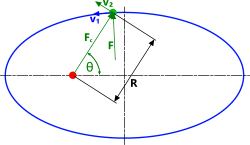
Fig 13. Centrifugal Force
Alternative Velocity Calculations
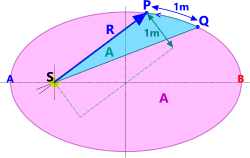
Fig 12. Alternative Velocity Calculation
A much simpler orbital velocity calculation method is based upon Kepler's 'swept-area = time' rule (Fig 12). Using the earth's orbit as an example:
Earth's total orbital area (A) is 7.029445371E+22m² and it takes 31558149s (t) to complete
The swept area (A) is equal to ½.R x 1m
The velocity of the orbiting body at any given distance between the centres of mass (P & S) is calculated as follows:
v = 2.A / t.R {m² / s.m = m/s}
By way of verification:
The earth's maximum velocity occurs when R = 1.47095E+11 m (@ A)
v = (2 x 7.029445371E+22) ÷ (31558118.4 x 1.47095E+11) = 30286.008788376 m/s
see Isaac Newton (1642 to 1727) above 30286.008788376 m/s (calculated using; h=v.R)
The earth's minimum velocity occurs when R = 1.52054683E+11 m (@ B)
v = (2 x 7.029445371E+22) ÷ (31558149 x 1.52103776E+11) = 29290.53557168 m/s
see Isaac Newton (1642 to 1727) above 29290.53557168 m/s (calculated using; h=v.R)
The above confirms Kepler's 'swept-area = time' rule and shows that v ∝ 1/R
or v = k/R
where k = 2.A / t
Another interesting velocity relationship is; vᴾ-vᴬ = e.(vᴾ+vᴬ)
where; 'vᴾ' is the satellite's orbital velocity at its perigee, 'vᴬ' is its orbital velocity at its apogee and 'e' is its orbital eccentricty
Another interesting velocity calculation involves the constants of proportionality and motion:
The average satellite velocity in elliprical and circular orbits may be calculated thus:
vₐᵥₑ = ½.(vᴬ+vᴾ) = (2π)² / K.h
Centripetal Force
In any orbiting system, the centripetal force, i.e. Newton's gravitational force (Fig 4), must be equal to the orbiting body's centrifugal force, which may be calculated thus (Fig 13):
F = m₂.v₁² / R
Fc = m₂.v₂² / R
where
v₂ = √[G.m₁ / R]
@ the perihelion (perigee) of an ellipse; Fc = F . ƒ/p = F / (1+e)
@ the aphelion (apogee) of an ellipse; Fc = F . p/ƒ = F . (1+e)
Orbital velocity anywhere in an orbit may be calculated thus:
v₁ = 2π.a.b / R.t
where t is the satellite's orbital period
Centrifugal velocity anywhere in an orbit may be calculated thus:
α = √[⁴/₃.π]
ζ = √[ (ƒ.Sin(θ/2)α + p.Cos(θ/2)α) / (ƒ.cos(θ/2)α + p.Sin(θ/2)α) ]
v₂ = ζ.v₁
Centrifugal acceleration: a = v²/R
Centrifugal force; F = m.a
where; R is the orbital radius
Refer to Formulas (below) for definitions of; G, m₁, a, b, R, t, ƒ & p
What Keeps a Satellite in its Orbit? (station-keeping)
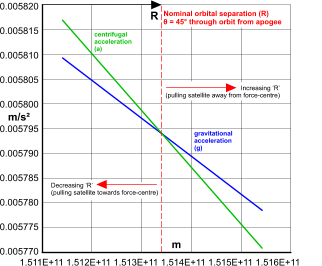
Fig 14. Keeping a Satellite in Orbit
When displacement forces pull a satellite off course, restoring forces will ensure that after release the satellite will return exactly to its orbital path, where both centrifugal and gravitational acceleration balance; i.e. where they are equal and opposite.
Fig 14 is a graphical representation of the restoration forces on the earth 45° through its orbital path from its apogee.
If the earth is pulled away from the sun (increasing R), gravitational acceleration (g) decreases slower than centrifugal acceleration (a), pulling the earth back towards the orbital path when the displacement force is released.
If the earth is pulled towards the sun (decreasing R), centrifugal acceleration (a) increases faster than gravitational acceleration (g), pulling the earth back towards the orbital path when the displacement force is released.
As you can see (Fig 14), exact balance occurs at the orbital path (nominal orbital separation 'R').
This relationship between centrifugal and gravitational acceleration is what maintains the orbital path in the event a satellite comes under the influence of external forces, and which CalQlata refers to as Station-Keeping.
None of the above is limited by satellite speeds, but it does require a perfect elliptical orbit, exactly as Kepler defined.
Unfortunately, Relativity is dependent upon imperfect elliptical orbits because the theory requires a variation in PE with radial distance from the force-centre, which is one of the principle reasons why relativity can no longer be considered a valid theory for the behaviour of matter in the universe.

Fig 15. Pulling a Satellite out of Orbit
Orbital Rotation
It is currently believed that satellites are [temporarily] pulled out of orbit by the gravitational pull of other celestial bodies passing nearby (Fig 15).
But given what we now know about station-keeping, that argument can no longer be considered correct.
Satellites passing close to each other must apply a torque to both of their elliptical orbital paths Fig 16, rotating their orbits about their force-centres.
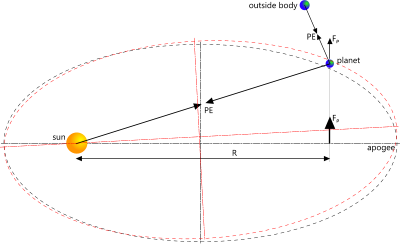
Fig 16. Orbital Rotation
This orbital rotation must result in some elliptical orbits crossing paths, which must occasionally result in inter-stellar (or planetary) satellite collisions.
And because many galactic satellites are also force-centres (stars and planets);
the impacted satellites will become belts of broken matter (e.g. our own Asteroid Belt), but their own sub-satellites (planets and moons) will be lost, to become galactic comets.
These galactic comets will therefore become the source of solar-system satellites and sub-satellites (planets and moons) throughout their galaxy.
The Formulas
It is important to understand that a force-centre mass defines its orbital shape(s) and velocity(ies), but it does not influence the satellite mass.
I.e. a satellite's mass is not dependent on its orbit.
This means that any two satellites may be swapped in their respective orbits, and their new velocities and orbital shapes will remain unchanged.
I.e. if you swapped Earth with Jupiter, the earth would follow the same orbital path, and travel at the same velocity, as Jupiter does today. And Jupiter would orbit as the earth does today.
Moreover, the most important property in calculating satellite orbits is the Constant of Proportionality (K), which is defined by the force-centre mass and remains identical for all satellites that orbit the same force-centre.
Once you have calculated this constant (K) for one orbit, it may be used as input to determine the shape of all other orbits around the same force-centre.
Whilst potential energy (PE) and kinetic energy (KE) both vary throughout an elliptical (not circular) orbit, the satellite's total [orbital] energy (E) remains constant;
E = KE + PE (where KE is positive and PE is negative).
The following Table comprises the complete set of orbital formulas that you need to determine the properties of any planetary orbit:
in the following Tables; Orbital Radius refers to the distance between the centres of the force-centre and satellite at the radius concerned
| Variable | Formula | Units | Description |
|---|---|---|---|
| R̂⁽¹⁾ | Input | m | Orbital Radius @ perigee |
| Ř⁽¹⁾ | Input | m | Orbital Radius @ apogee |
| θ⁽²⁾ | Input | ° | angle through orbit (Fig 5) |
| t | Input | s | orbit period |
| Input Data Notes: 1) Only one of these values is required for all orbits around the same force-centre once K has been established for the first orbit 2) Only required for a satellite between its orbital apogee and perigee |
|||
| Variable | Formula | Units | Description |
|---|---|---|---|
| a | (R̂+Ř)/2 or ³√[ t²/K ]⁽¹⁾ | m | major semi-axis (Fig 5) |
| K | t²/a³ | s²/m³ | constant of proportionality⁽²⁾ |
| ƒ | R̂ | m | Orbital Distance @ perigee (Fig 5) |
| x' | a-ƒ | m | orbit centre distance (Fig 5) |
| e | (-R̂ + √[R̂² - 4.a.{R̂-a}]) / 2.a | eccentricity | |
| b | √[a².(1-e²)] | m | minor semi-axis (Fig 5) |
| p | a.(1-e²) | m | half-parameter |
| A | π.a.b | m² | orbit total area |
| L | π . √[ 2.(a²+b²) - (a-b)² / 2.2 ] | m | orbital circumference |
| R | p / [1 – e.Cos(θ)] | m | Orbital Radius @ θ (Fig 5) |
| v | 2.A / t.R | m/s | orbital velocity @ R |
| g | -v.vᴬ / R.(1-e)⁽³⁾ | m/s² | gravitational acceleration @ R |
| Orbital Shape Notes: 1) This formula may be used to calculate a once K has been established for the first orbit 2) This value may be used to calculate Ř or R̂ for all other orbits around the same force-centre 3) vᴬ = satellite velocity at its orbital apogee 4) CaQlata has released online and downloadable calculators for the above formulas. |
|||
| Variable | Formula | Units | Description |
|---|---|---|---|
| m₁⁽¹⁾ | (2.π)² / G.K | kg | force-centre mass |
| m₂ | Input | kg | satellite mass |
| Body Masses Notes: 1) This value becomes input after it has been calculated for the first orbit of a given force-centre |
|||
| Variable | Formula | Units | Description |
|---|---|---|---|
| F | g.m₂ | N | gravitational force on satellite |
| PE | F.R | J | potential energy between force-centre and satellite |
| KE | ½.m₂.v² | J | kinetic energy in satellite⁽¹⁾ |
| E | PE+KE | J | total energy⁽²⁾ |
| P | F.v | J/s | satellite power |
| p | m₂.v | kg.m/s | satellite momentum |
| h | v.R | m²/s | Newton's motion constant |
| Satellite Performance Notes: 1) This value does not include angular momentum, which plays no part on Newton's laws of orbital motion 2) This value does not change throughout a satellite's orbit (it is a constant for the satellite in its orbit) |
|||
We have used the above formulas to calculate the properties of a number of orbits (below). Where CalQlata's input data is exactly the same as that provided by NASA, CalQlata has used NASA's data.
We may find the swept area (Aꞌ) and time elapsed (tꞌ) from the orbital apogee at any angle (θ) like this:
Aꞌ = ½.a.b.θ
tꞌ = t.Aꞌ/A
where; t, θ, a, b & A are as defined in the above Table.
The Earth's Orbit
The following table contains the results for the earth's orbit around the sun using the above formulas:
| Variable | Calculation Results | Units | NASA Fact Sheet |
|---|---|---|---|
| Force Centre | |||
| m₁ | 1.9885E+30 | kg | 1.9885E+30 |
| m₂ | 5.96451976771313E+24 | kg | 5.9723E+24 |
| t | 31558118.4 | s | 31558118.4 |
| Orbit Shape | |||
| a | 1.49594598077542E+11 | m | 149.6E+09 |
| b | 1.49573713544299E+11 | m | - |
| e | 0.01670914665145 | 0.0167 | |
| p | 1.49552831926695E+11 | m | - |
| ƒ | 1.47095E+11 | m | 147.09E+09 |
| x' | 2499598077.54199 | m | - |
| L | 9.39864971227182E+11 | m | - |
| K | 2.9749143643471E-19 | s²/m³ | - |
| A | 7.02944537126484E+22 | m² | - |
| Satellite Properties at Perigee | |||
| R̂ | 1.47095E+11 | m | 147.09E+09 |
| F̌ | -3.65817880452228E+22 | N | - |
| F̌c | 3.65817880452228E+22 | N | - |
| g | -0.00613323276138 | m/s² | - |
| v̌ | 30286.0087883763 | m/s | 30290 |
| h | 4.45492046272622E+15 | m²/s | - |
| PE | -5.38099811251204E+33 | N.m | - |
| KE | 2.73545499955258E+33 | N.m | - |
| E | -2.64554311295946E+33 | N.m | - |
| P | -1.106679859023110E+27 | J/s | - |
| Satellite Properties at Apogee | |||
| Ř | 1.52094196155084E+11 | m | 152.1E+09 |
| F̂ | -3.42164907786915E+22 | N | - |
| F̂c | 3.42069376856408E+22 | N | - |
| g | -0.00573667153623 | m/s² | - |
| v̂ | 29290.5355716777 | m/s | 29290 |
| h | 4.45492046272622E+15 | m²/s | - |
| PE | -5.20412966023294E+33 | N.m | - |
| KE | 2.55858654727348E+33 | N.m | - |
| E | -2.64554311295946E+33 | N.m | - |
| P | -1.001100808727080E+27 | J/s | - |
The Moon's Orbit
The following table contains the results for the moon's orbit around the earth using the above formulas:
| Variable | Calculation Results | Units | NASA Fact Sheet |
|---|---|---|---|
| Force Centre | |||
| m₁ | 5.96451976771313E+24 | kg | - |
| m₂ | 7.346377413717920E+22 | kg | 7.346E+22 |
| t | 2360620.8 | s | 2360594.88 |
| Orbit Shape | |||
| a | 383006000 | m | 3.844E+08 |
| b | 382284501.427929 | m | - |
| e | 0.06135151929735 | 0.0549 | |
| p | 381564361.999551 | m | - |
| ƒ | 359508000 | m | 3.633E+08 |
| x' | 23498000 | m | - |
| L | 2404231599.95269 | m | - |
| K | 9.918265428164E-14 | s²/m³ | - |
| A | 4.599833813184E+17 | m² | - |
| Body Properties at Perigee | |||
| R̂ | 359508000⁽⁶⁾ | m | 3.633E+08 |
| F̌ | -2.26245592916E+20 | N | - |
| F̌c | 2.26245592916E+20 | N | - |
| g | -0.0030796892152 | m/s² | - |
| v̌ | 1084.02013382669 | m/s | 1076 |
| h | 3.89713910272E+11 | m²/s | - |
| PE | -8.13371006179E+28 | N.m | - |
| KE | 4.31636276580E+28 | N.m | - |
| E | -3.81734729599E+28 | N.m | - |
| P | -1.1625848445331E+19 | J/s | - |
| Body Properties at Apogee | |||
| Ř | 406504000 | m | 4.055E+08 |
| F̂ | -1.769569399E+20 | N | - |
| F̂c | 1.76290872399E+20 | N | - |
| g | -0.0024087646187 | m/s² | - |
| v̂ | 958.696372659963 | m/s | 964 |
| h | 3.89713910272E+11 | m²/s | - |
| PE | -7.19337038970E+28 | N.m | - |
| KE | 3.37602309371E+28 | N.m | - |
| E | -3.81734729599E+28 | N.m | - |
| P | -1.0611125866898E+19 | J/s | - |
Jupiter's Orbit
The following table contains the results for Jupiter's orbit around the sun using the above formulas:
| Variable | Calculation Results | Units | NASA Fact Sheet |
|---|---|---|---|
| Force Centre | |||
| m₁ | 1.9885E+30 | kg | 1.9885E+30 |
| m₂ | 1.89819E+27 | kg | 1.89819E+27 |
| t | 374335689.6 | s | # |
| Orbit Shape | |||
| a | 778065216557.462 | m | 7.7857E+11 |
| b | 777158824134.593 | m | - |
| e | 0.048254588122549 | 0.0489 | |
| p | 776253487596.51 | m | - |
| ƒ | 7.4052E+11 | m | 7.4052E+11 |
| x' | 37545216557.4618 | m | - |
| L | 4885880873527.98 | m | - |
| K | 2.9749143643471E-19 | s²/m³ | - |
| A | 1.89965902740038E+24 | m² | - |
| Body Properties at Perigee | |||
| R̂ | 7.4052E+11 | m | 7.4052E+11 # |
| F̌ | -4.59358084575704E+23 | N | - |
| F̌c | 4.59358084575704E+23 | N | - |
| g | -0.00024199794782172 | m/s² | - |
| v̌ | 13705.9020494021 | m/s | 13720 |
| h | 1.01494945856233E+16 | m²/s | - |
| PE | -3.40163848790001E+35 | N.m | - |
| KE | 1.78289157603771E+35 | N.m | - |
| E | -1.61874691186229E+35 | N.m | - |
| P | -6.29591691279559E+27 | J/s | - |
| Body Properties at Apogee | |||
| Ř | 815610433114.924 | m | 8.1662E+11 |
| F̂ | -3.78668695979922E+23 | N | - # |
| F̂c | 3.77786963923902E+23 | N | - # |
| g | -0.00019948935353148 | m/s² | - |
| v̂ | 12444.0470272812 | m/s | 12440 |
| h | 1.01494945856233E+16 | m²/s | - |
| PE | -3.08846139135248E+35 | N.m | - |
| KE | 1.46971447949018E+35 | N.m | - |
| E | -1.61874691186229E+35 | N.m | - |
| P | -4.71217106053339E+27 | J/s | - |
| # this discrepancy is due to incorrect input data | |||
Halley's Comet Orbit
The following table contains the results for Halley's comet orbiting the sun using the above formulas:
| Variable | Calculation Results | Units | NASA Fact Sheet |
|---|---|---|---|
| Force Centre | |||
| m₁ | 1.9885E+30 | kg | 1.9885E+30 |
| m₂ | 2.2E+14 | kg | 2.2E+14 |
| t | 2399889600 | s | 2399889600 # |
| Orbit Shape | |||
| a | 2685154954222.11 | m | 2.68378579E+012 {17.94 AU} |
| b | 680514289761.4 | m | - |
| e | 0.96735221865943 | 0.967 | |
| p | 172466657032.711 | m | - |
| ƒ | 87664351811 | m | 8.76643518E+10 {0.587 AU} |
| x' | 2597490602411.11 | m | - |
| L | 11551360845882.2 | m | - |
| K | 2.9749143643471E-19 | s²/m³ | - |
| A | 5.74058926814732E+24 | m² | - |
| Body Properties at Perigee | |||
| R̂ | 87664351811 | m | 8.76643518E+10 {0.587 AU} # |
| F̌ | -3.79893529804621E+12 | N | - |
| F̌c | 3.79893529804620E+12 | N | - |
| g | -0.017267887718392 | m/s² | - |
| v̌ | 54572.2903020136 | m/s | - |
| h | 4.78404445616775E+15 | m²/s | - |
| PE | -3.33031200475149E+23 | N.m | - |
| KE | 3.27594835568798E+23 | N.m | - |
| E | -5.43636490635095E+21 | N.m | - |
| P | -3.0290786373017E+13 | J/s | - |
| Body Properties at Apogee | |||
| Ř | 5282645556633.23⁽⁸⁾ | m | - |
| F̂ | -1.04617660564637E+09 | N | - # |
| F̂c | 6.71955938922448E+07 | N | - # |
| g | -0.000004755348207 | m/s² | - |
| v̂ | 905.6152650939 | m/s | - |
| h | 4.78404445616775E+15 | m²/s | - |
| PE | -5.52658019727142E+21 | N.m | - |
| KE | 9.02152909208292E+19 | N.m | - |
| E | -5.43636490635059E+21 | N.m | - |
| P | -3.0290786373017E+13 | J/s | - |
| # this discrepancy is due to incorrect input data | |||
If your calculations result in a positive energy (E) and/or a negative velocity (v̂) at your apogee, the body will not complete an elliptical orbit, it will fly off into outer-space. In which case, the orbital shape will be parabolic.
Important: It is a fundamental conclusion of Isaac Newton's laws of motion that if positions 1 and 2 in any orbit are 180° apart ...
... the difference between the velocities of a satellite at these two orbital positions divided by their sum is always equal to the eccentricity of the orbit; i.e. e = (v₁-v₂)/(v₁+v₂)
... the difference between the potential energies of a satellite at position 1 is always equal to minus the difference between its kinetic energies at position 2; i.e. (PE₁ - PE₂) = -(KE₁ - KE₂)
... the potential energy anywhere in a circular orbit is always minus twice the kinetic energy anywhere in the same orbit; i.e. PE = -2.KE (see Emc2 below)
... the total energy (E) of a satellite remains constant anywhere in its orbit
E=mc² (circular orbits)
If we set any elliptical orbit to an eccentricty of zero (circular) PE is always twice KE. The following Table calculates Earth's orbit using the above formulas:
| Property | equivalent circular orbit formula | Earth's [circular] Orbit | Units |
|---|---|---|---|
| m₁ | 1.9885E+30 | kg | |
| m₂ | 1.89819E+27 | Kg | |
| t | 31558118.4 | s | |
| Orbital Shape: | |||
| a | R | 1.47095E+11 | m |
| b | R | 1.47095E+11 | m |
| e | 0 | 0 | |
| p | R | 1.47095E+11 | m |
| ƒ | R | 1.47095E+11 | m |
| x' | 0 | 0 | m |
| L | 2πR | 9.24225142759581E+11 | m |
| K | t²/R³ | 3.12916504816786E-19 | s²/m³ |
| A | πR² | 6.79744486871103E+22 | m² |
| @ Perigee: | |||
| R̂ | R | 1.47095E+11 | m |
| F̌ | m₁.g | -3.47785064239271E+22 | N |
| g | -G.m₁/R² | -0.00583089800660709 | m/s² |
| v̌ | 2.A / t.R | 29286.4463921772 | m/s |
| h | R.v | 4.30788983205731E+15 | m²/s |
| PE | F.R | -5.11574440242755E+33 | N.m |
| KE | ½.m.v² | 2.55787220121378E+33 | N.m |
| E | KE+PE | -2.55787220121378E+33 | N.m |
| @ Apogee: | |||
| Ř | R̂ | 1.47095E+11 | m |
| F̂ | F̌ | -3.47785064239271E+22 | N |
| g | g | -0.00583089800660709 | m/s² |
| v̂ | v̌ | 29286.4463921772 | m/s |
| h | h | 4.30788983205731E+15 | m²/s |
| PE | PE | -5.11574440242755E+33 | N.m |
| KE | KE | 2.55787220121378E+33 | N.m |
| E | E | -2.55787220121378E+33 | N.m |
| PE:KE | PE/KE | -2.000000000000000000 | N.m |
As can be seen above; PE = -2xKE (exact).
Swapping Orbits
As can be seen in the Table below, using Newton's laws of motion it is possible to put Jupiter, for example, in Earth's orbit without altering the orbital shape. The observable orbit is not therefore an indicator of a planet's mass.
| Property | Earth in Earth Orbit | Jupiter in Earth Orbit | Units |
|---|---|---|---|
| m₁ | 1.9885E+30 | 1.9885E+30 | kg |
| m₂ | 5.966585416E+24 | 1.89819E+27 | Kg |
| Orbital Shape: | |||
| t | 31558118.4 | 31558118.4 | s |
| a | 1.495945981E+11 | 1.49594598E+11 | m |
| b | 1.495737135E+11 | 1.49573714E+11 | m |
| e | 0.01670914665 | 0.016709146651 | |
| p | 1.495528319E+11 | 1.49552832E+11 | m |
| ƒ | 1.47095E+11 | 1.47095E+11 | m |
| x' | 2.499598078E+09 | 2.49959808E+09 | m |
| L | 9.398649712E+11 | 9.39864971E+11 | m |
| K | 2.974914364E-19 | 2.97491436E-19 | s²/m³ |
| A | 7.029445371E+22 | 7.02944537E+22 | m² |
| @ Perigee: | |||
| R̂ | 1.47095E+11 | 1.47095E+11 | m |
| F̌ | 3.658178805E+22 | 1.16420411E+25 | N |
| g | -0.006133232761 | -0.006133232761 | m/s² |
| v̌ | 30286.008788376 | 30286.00879 | m/s |
| h | 4.454920463E+15 | 4.45492046E+15 | m²/s |
| PE | -5.38099811E+33 | -1.71248603492E+36 | N.m |
| KE | 2.735455E+33 | 8.70550107606E+35 | N.m |
| E | -2.64554311E+33 | -8.41935927310E+35 | N.m |
| @ Apogee: | |||
| Ř | 1.520941962E+11 | 1.52094196E+11 | m |
| F̂ | 3.421649078E+22 | 1.08892925E+25 | N |
| g | -0.005736671536 | -0.00573667154 | m/s² |
| v̂ | 29290.53557 | 29290.53557 | m/s |
| h | 4.454920463E+15 | 4.45492046E+15 | m²/s |
| PE | -5.20412966E+33 | -1.65619819608E+36 | N.m |
| KE | 2.55858655E+33 | 8.14262268768E+35 | N.m |
| E | -2.64554311E+33 | -8.41935927310E+35 | N.m |
| The above calculations have been carried out using Newton's laws of planetary motion | |||
As can be seen in Fig 17, there is no relationship between the mass (m₂) of the planets and comets in our solar system (Mercury to P/2009 WX51 Catalina [CSS]) and their orbital properties.
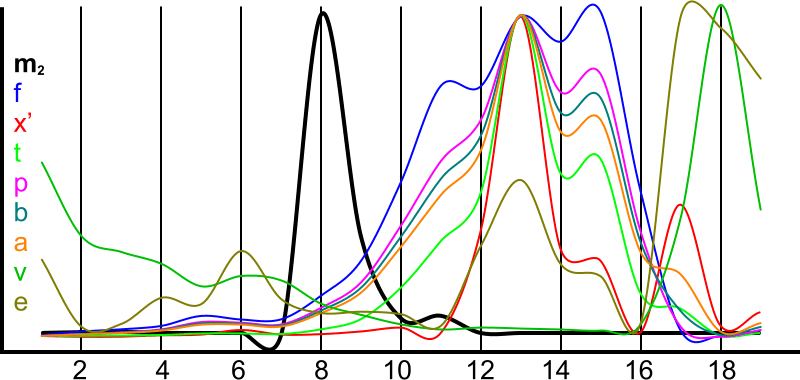
Moreover, given that:
centrifugal force (Fc) on a satellite must equal potential force (Fp) for a satellite to maintain its orbit:
Fc = Fp
Fc = m₂.v²/R
Fp = G.m₁.m₂/R²
v = 2.A / t.R
m₂.(2.A / t.R)²/R = G.m₁.m₂/R²
4.(A/t)²/R = G.m₁
and
PE = G.m₁.m₂/R² and KE = ½.m₂.v²
and G & m₁ are both common throughout any orbit in the same orbital system,
and because Rᴬ/Rᴾ = vᴾ/vᴬ = PEᴾ/PEᴬ = √[KEᴾ/KEᴬ]
it is clear that any value for m₂ (satellite mass) may be applied to any orbital calculation without upsetting the orbital shape and/or period,
confirming that satellites may be swapped without affecting orbital properties.
Note: 'ᴬ' represents orbital apogee and 'ᴾ' represents orbital perigee
Linear Orbits
The elliptical orbit described above is not the only orbital category.
If you initiate an explosive rupture of a massive body (m) in empty space, most of the ejected matter will travel [linearly] away from the explosion. But some of it will remain 'in-place'; as residual matter or 'force-centre' (m₁).
This force-centre will induce a gravitational attraction (g) in all the ejected matter slowing down its outward travel.
The energy released by the explosion (E) will initially be induced in all the ejected matter as kinetic energy, giving it an initial velocity (u). But the acceleration (a) in the ejected matter will remain constant throughout the orbit; until its outward travel comes to a halt and thereafter returns to its force-centre, augmenting its mass.
This process has just one circuit from start to finish. You can calculate a satellite’s performance from its share of the ejected energy; E₂ = E . m₂/m. This is a 'linear orbit' following a 'Big-Bang'. The force-centre is called the great attractor, and the satellite is called a galactic force-centre.
The input data you need to analyse this type of orbit is as follows:
m; the mass of the massive body
E; the energy released by the explosive rupture
m₁; force-centre mass (residual matter)
m₂; satellite mass
It is important to note that this type of orbit also has a constant of proportionality:
K = (2π)² / (m₁.G) = (2π)² / (Rₒ.u²/2) = 2π² . tₒ²/Rₒ³
For any given satellite:
u = √[2.E/(m-m₁)]
E₂ = E . m₂/m
K = (2π)² / (m₁.G)
Rₒ = (2π)² / (½.u².K)
tₒ = √[½.K.Rₒ³] / π
At any point during its orbit:
the distance reached by the satellite; R = ³√[2π² . t²/K]
or
the time elapsed since the 'Big-Bang'; t = √[K.R³ / 2π²]
and
the satellite's acceleration; a = -u/tₒ (constant)
the gravitational attraction in the satellite; g = -G.m₁/R² (variable)
At ‘tₒ’: PE must equal KE immediately after the ‘Big-Bang’ and ‘g’ must equal ‘a’.
The only difference between the linear and elliptical orbits is that linear orbits do not have a constant of motion.
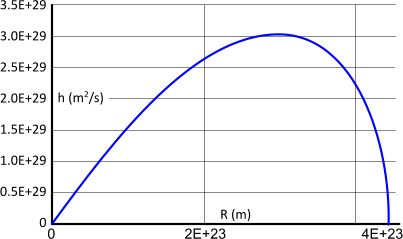
Fig. 18 Newton's Constant of Motion for Linear Orbits
We know this to be the case because there is a known relationship between both of Newton's orbital constants 'K' & 'h';
(2π)² . KE/PE . 2/(R.v²) = (2π)² / (G.m₁)
(2π)² . KE/PE . 2/(h.v) = (2π)² / (G.m₁)
1 . KE/PE . 2/(h.v) = 1 / (G.m₁)
KE/PE . 2.(G.m₁) = (h.v)
KE/PE . 2.(G.m₁) / v = h
h = 2.G.m₁.KE / PE.v {m³/kg/s² . kg . J / J . s/m = m²/s}
h = 2.G.m₁.(½.m₂.v²) / (G.m₁.m₂/R) / v = R.v
K = (2π)² / G.m₁ = (2π)² . KE/PE . 2/(R.v²)
K.h = 2.(2.π)².KE / PE.v
h = 2.(2.π)² / K.v . KE/PE (Fig 18)
h = 2.(G.m₁)/v . KE/PE
Because a galactic force-centre has a force-centre of its own (the great attractor), and spins due to its stellar population, it will generate internal frictional heat, but only due to E₃ (E₀ & E₁ are both zero). it is for this reason that the temperature of a galactic force-centre is not expected to be much above that of outer-space; 2.7255 K
Calculating Planetary Mass
So, if you can't determine a satellite's mass simply from its orbit and its velocity within it (see Swapping Orbits above), how do you calculate the mass of everything in the solar system with only a ball of known mass, a watch and Tycho Brahe's orbital data?
Galileo kicked us off with his discovery of gravitational acceleration, albeit his attempts to find an accurate value were hampered by his inability to measure time accurately.
Kepler gave us the next step with his definition of elliptical orbits and his law of equal orbital time and swept-Area.
Newton put it all together ...
... and it works like this:
By dropping our ball (or rolling it down a slope) and measuring the time it takes to cover a known height, we can find the gravitational acceleration on the surface of our planet, an accurate value for which is now available:
The earth's mean radius: R = 6367444.5 m
The earth's mean gravitational acceleration at sea level: g = 9.80663139027614 m/s²
Newton's gravitational constant: G = 6.67359232004332E-11 m³/kg/s² (see G below)
Using Newton's formula; g = G.m₂/R², we can now determine the earth's mass (m₂)
As we know the earth's orbital shape and its velocity (v) at any point within it, we can accurately determine its centrifugal force (Fc) at its perigee for example, from; Fc = ƒ/p . m₂.v²/R
and because we know that the gravitational force between the earth and sun is exactly the same as the earth's centrifugal force (i.e. they balance each other exactly), we can establish the mass of our sun (m₁) using; Fc = G.m₁.m₂ / R² ⁽⁹⁾
Knowing the mass of the sun and the earth along with the orbital shape of the other bodies in our solar system, we can calculate their masses by comparing force-triangles, one from a planet's theoretical orbit and the other as it passes close to one of which its mass is known, using its orbital deviation and the formulas: g = G.m₁/R² & m₂ = F.R² / G.m₁
So, from measuring the time it takes to drop a ball anywhere on our planet, along with the observed orbits for all the planets and moons in the solar system, Newton has given us all we need to calculate every one of their masses, including that of the sun.
In conjunction with their spin properties, you can also estimate a planet's internal composition.
Fundamental Laws of Orbital Motion
1) Every orbital system must include only one force-centre and at least one satellite.
2) A force-centre's mass defines all of its satellite orbits; K = (2π)² / G.m₁ = t²/a³
t = orbital period & a = half the length of the orbital major axis.
3) The combined energy in all the satellites define their force-centre's spin-rate.
4) Apart from a sufficiently large external force, nothing can cause a satellite to leave its orbit.
5) External influences affect orbits only temporararily. The theoretical orbit will always be recovered if those influences are removed.
What is Gravity?
In his studies of the atom, Keith Dixon-Roche has concluded that gravity is magnetism
Epilogue
Newton's Principia covered a good deal more than the above, but we have limited our selection to those theories necessary to calculate the behaviour of a single orbiting body.
What makes the above all the more startling is that Newton achieved it with his simple diagram (Fig 8), a new and (as yet) untried mathematical process (calculus) and no computational assistance {none of which can be claimed by CalQlata}
We {@ CalQlata} are suitably impressed
Notes
- Giordano Bruno (friar, mathematician and astrologer) was burnt to death in 1600 by the religious authorities for suggesting that the stars were other suns with orbiting planets, and Galileo was forced to recant his findings in order to escape the same fate
- The projectile is fired from the surface at 67° with an initial velocity of 10.06761m/s. The half-parameter (p) of the parabolic curve with the best parallel match is 1.58m and the half-parameter (p) for the curve that passes through the same co-ordinates at the latus rectum is 1.7m
- Gottfried Leibniz (1646 to 1716) created his own version of calculus after meeting with Isaac Newton in 1676, during which he may have been given sight of Newton's work on the subject from about 1666
- NASA fact sheet for Earth
- The sun's mass (m₁) has been optimised against the gravitational constant (G) to give a zero error margin for all calculations
- Figures for March 2016 were selected for this calculation as they represent the lowest error margin (0.033389%) when compared with the expected (theoretical) distance at the apogee
- Halley's comet is not spherical, it is roughly cylindrical/oblong (like a peanut, potato, etc.). This radius is calculated by converting an equivalent cylinder into a sphere of the same volume. Minor variations in this variable will have no effect on the above results.
- Neptune's orbit is about 4.5E+012m
- The calculation for each planetary mass should include the masses of their moons, but because moons tend to be so much smaller than their planets (except Pluto), ignoring them will make little difference to the final result.
Further Reading
You will find further reading on this subject in reference publications(55, 60, 61, 62, 63 & 64)